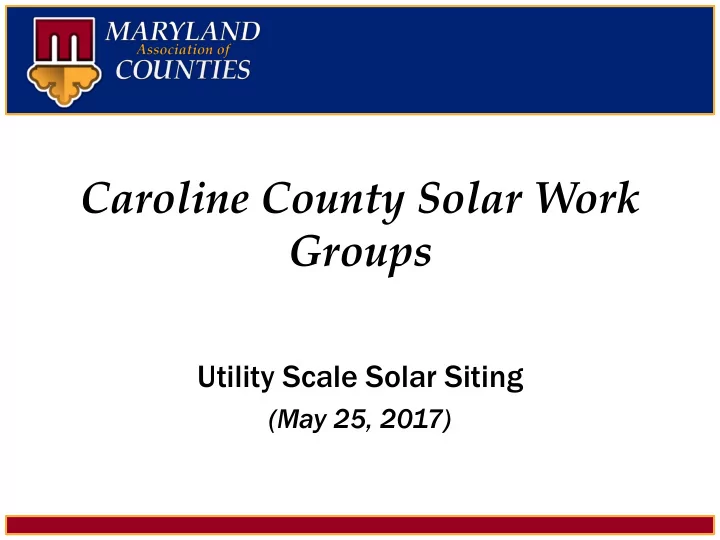

Caroline County Solar Work Groups Utility Scale Solar Siting (May 25, 2017)
Presentation Summary Overview of Maryland’s Certificate of Public Convenience and Necessity (CPCN) Process for Energy Generation Sites Review of 2017 MACo Energy Siting Legislation (HB 1350) Issues for County Consideration When Developing an Energy Siting Policy 2
The CPCN Process Public Service Commission (PSC) reviews and approves requests for CPCN Power Plant Research Program (PPRP) serves as a separate advisory body to PSC that reviews environmental and economic impacts of proposed facilities Power Plant Siting Act of 1971 (SB 540) gave PSC preemption authority over local governments for energy generation facilities and transmission lines Electric Customer Choice and Competition Act of 1999 (HB 703/SB 300) deregulated electric utilities and added economic/profit factors to CPCN process 3
The CPCN Process Sections 7-207, 7-207.1, and 7-208 of the Public Utilities Article key statutes for CPCN process CPCN process applies to most energy generation facilities over 2 Mega Watts (MW) 2 MW solar or wind farm will roughly take ~10 acres of land according to Power Plant Research Program (PPRP) CPCN Exemptions Generation capacity <= 2 MW Generation capacity up to 25 MW AND at least 10% of energy consumed on site Generation capacity up to 70 MW AND at least 80% of energy consumed on site Land-based wind generation capacity up to 70 MW 4
The CPCN Process Pre-application No formal requirements but PPRP encourages energy developers to meet with PPRP staff to identify potential issues of concern with the proposed generation or transmission project to reduce risk of a rejected CPCN application Application CPCN applicant must summarize the proposed project and its potential environmental, social, cultural, and economic impacts PPRP, in coordination with other State agencies, evaluates the potential impacts of the proposed project on Maryland’s resources, including water (surface and ground water), air, land, ecology, and socioeconomics, including visual and noise-related impacts For transmission lines, the need for the project is evaluated and a review of alternative routes is conducted 5
The CPCN Process PSC Review Public Utility Law Judge (PULJ) typically assigned to each application and schedules a pre-hearing conference to establish an overall procedural schedule, including dates for evidentiary and public hearings Adjudicatory process commences with a discovery phase, and proceeds to the filing of direct testimony from the applicant summarizing the impact analyses that have been completed and providing the basis for the applicant’s request for a CPCN PSC holds evidentiary hearing during which all the parties to the proceeding may actively participate and file their findings as formal testimony PPRP and any other parties that have intervened in the process may cross examine applicant testimony and present their own analyses in direct testimony PULJ also presides over public hearings to accept 6 comments on a project from the general public
The CPCN Process PSC Decision PULJ takes into consideration the briefs filed by the applicant, the State, and any other parties, recommended license conditions, and public testimony, and issues a decision in the form of a Proposed Order on whether or not the CPCN should be granted and under what conditions After a prescribed appeal period, a Final Order is released by PSC granting or denying CPCN Appeals PULJ Proposed Order can be appealed to full 5-member PSC PSC Order can be appealed to the Circuit Court Circuit Court Order can be appealed to Court of Special Appeals and then Court of Appeals 7
The CPCN Process PSC Must Give Due Consideration to Certain Factors (§ 7-207(e) of Public Utility Article) Recommendation of local governments where project will be located Stability and reliability of electric system Economics Esthetics Historic Sites Aviation safety Air and water pollution Disposal of wastes produced by generating station Several recent PSC decisions indicate PSC takes local concerns seriously Mills Branch Solar (Case 9411) in Kent County Dan’s Mountain Wind Force (Case 9413) in Allegany County 8
2017 MACo Legislation Energy siting was a 2017 MACo Legislative Initiative Concerns over large amounts of land being optioned for energy generation facilities, disruption of local land use planning, and possibility of preemption for several controversial projects 9
2017 MACo Legislation HB 1350 of 2017 (passed) As part of CPCN process, PSC must give due consideration to: The consistency of the application with the comprehensive planning and zoning of each local government where project will be located The efforts by affected parties to resolve any issues presented by an affected local government PSC must provide notice and a copy of any CPCN application to executive branch of each affected local government in addition to local governing body and offer to provide a copy to the relevant State delegation Other Commitments PPRP informal study on notice and communication Best practices for utility scale solar developers Senate discussion on setting protections for preserved lands and Rural Legacy Areas 10 Legislative “Breather”
Issues for County Consideration Understanding of solar technology Benefits and drawbacks of utility scale solar Factors needed for viable sites, including grid connectivity Comprehensive planning and zoning goals Agricultural, environmental, and historic preservation concerns Citizen concerns Passing the PSC “smell test” to avoid preemption Tax and revenue issues 11
QUESTIONS? Leslie Knapp Jr. Legal and Policy Counsel Maryland Association of Counties lknapp@mdcounties.org Phone: 410.269.0043 12
Recommend
More recommend